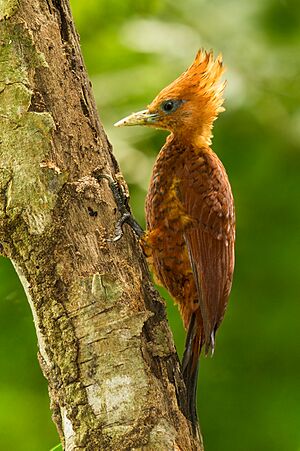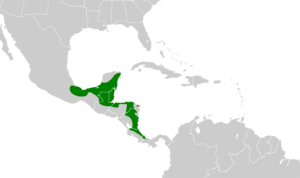Chestnut-colored woodpecker facts for kids
Quick facts for kids Chestnut-colored woodpecker |
|
|---|---|
 |
|
| Adult female | |
| Conservation status | |
| Scientific classification | |
| Genus: |
Celeus
|
| Species: |
castaneus
|
 |
|
The chestnut-colored woodpecker (Celeus castaneus) is a type of bird from the woodpecker family. It lives in parts of Central America, including Belize, Costa Rica, Guatemala, Honduras, Mexico, Nicaragua, and Panama. This bird is known for its beautiful chestnut (reddish-brown) feathers.
Contents
About the Chestnut-colored Woodpecker
The chestnut-colored woodpecker is the only species in its group, meaning it's quite unique!
What Does This Woodpecker Look Like?
This woodpecker is about 21.5 to 25 centimeters (8.5 to 10 inches) long. It weighs between 80 and 105 grams (about 3 to 3.7 ounces).
Both male and female woodpeckers have a dull yellowish-brown head with a pointy crest. Male birds have bright red feathers from their eyes down to their throat. Females do not have this red color.
Both adult males and females have reddish-brown upper bodies. Their lower back is a cinnamon-buff color. They also have black bars on their back and upper tail feathers. Their flight feathers are reddish-brown with some dark brown tips. Their tail feathers are dull black with reddish-brown bases.
Their undersides are reddish-brown with many black "V" or "U" shapes. The amount of black can be a bit different from one bird to another. Adult woodpeckers have an ivory-yellow beak with a blue-green tint at the base. Their eyes are chestnut or dark red, and their legs are dark olive or grayish.
Young woodpeckers look similar to adults. However, they are generally duller and darker. They might have dark spots on their cheeks. They also have fewer and more uneven black marks on their undersides.
Where Do Chestnut-colored Woodpeckers Live?
You can find the chestnut-colored woodpecker on the Caribbean side of Central America. Their home stretches from southern Mexico down through Belize, Guatemala, Honduras, Nicaragua, and Costa Rica. They also live a little bit into Panama.
These woodpeckers mostly live inside and at the edges of humid evergreen forests. They also like semi-deciduous forests, which lose some leaves. Sometimes, they can be found in mangrove swamps and coastal areas with small trees and bushes. They prefer places with thick leaves, even at the forest edge.
They live from sea level up to about 1,000 meters (3,300 feet) high in Mexico. In Costa Rica, they live up to about 750 meters (2,500 feet) high.
Woodpecker Behavior
How They Move Around
The chestnut-colored woodpecker stays in the same area all year long. It does not migrate to different places.
What They Eat and How They Find Food
These woodpeckers mainly eat ants and termites. They also eat smaller amounts of other insects and fruit. They usually look for food by themselves. Sometimes, you might see them foraging in pairs.
They search for food high up in the trees, in the canopy and subcanopy. At the forest edges, they might look for food lower down. They find their prey by pecking into tunnels in trees. They also pry off bark to find insects hiding underneath.
How They Raise Their Young
The breeding season for the chestnut-colored woodpecker changes depending on where they live. For example, they might breed from March to June in Oaxaca, Mexico. In Belize, it's from April to July.
Both the male and female woodpeckers work together to dig out a nest hole. Most of the nests found have been inside a tree. One nest was found to have four eggs. Scientists are still learning about how long the eggs take to hatch. They also don't know how long it takes for the young birds to leave the nest. More details about how the parents care for their chicks are also unknown.
Sounds They Make
The chestnut-colored woodpecker has a common call that sounds like a falling "skeew." This is often followed by a nasal "keh, keh, keh." They also make a sharp, two-part "wi-kah" sound. Another call is a nasal "peahh," which sounds a bit like a squeeze toy. When they drum on trees, they make a short series of fast, hollow taps.
Conservation Status
The IUCN (International Union for Conservation of Nature) says the chestnut-colored woodpecker is a species of "Least Concern." This means it is not currently in danger of disappearing. It lives across a large area. Scientists estimate there are at least 50,000 adult birds. However, this number is thought to be slowly going down.
No immediate big threats have been found for this bird. But like other forest birds, the chestnut-colored woodpecker could be at risk if its forest home is lost or damaged.


